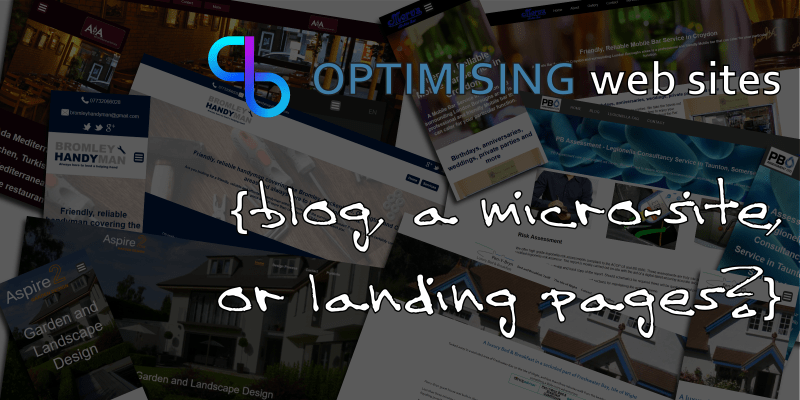ブログ、マイクロサイト、またはランディング ページの選択についてサポートが必要ですか?
What is a landing page?

A landing page is generally any page that the user first lands on when they arrive at your site, so could be the home/about page, a blog post, product page or lead capture page.
However, when described in online marketing, it is usually defined as a page that is specifically designed to receive and convert traffic from an online campaign.
Anyway, we don’t want to argue about the semantics of a word, read on for our opinion on what options you have and make up your own mind.
What strategies are available?
There are a number of options available dependent on the amount of effort you are willing to put in.
We have seriously considered separating out each part of our site into micro-sites and Claytabase, with the related blog posts and landing pages moving with them.
Blog Posts
Creating blog posts will require the most effort, and potentially monetary investment if you wanted to get some guest posts, however in terms of building a strong brand and level of trust, it could separate you from the rest of the industry you are in.
One of the main advantages of using blog posts is the ability to create keyword rich posts that you can then funnel the reader into another section of the site selling the related service, product or information gathering section.
When should you use a blog?
- You want to be a long term player using Search Engine Optimisation techniques.
- You have lots of centralised content that can be kept up to date and branded across all pages
- You want to make money online advertising banners like Google Ad-sense or Bing, or privately sponsored sections on your site
- You want to grow your reputation as one of the industry leaders and don’t mind sharing some tips for free to help others
- You want to provide a self-help service or journey
Micro-site(s)
Limited function web site with perhaps 4 to 5 pages and stripped back navigation to avoid distracting the user from the current task you want them to perform.
Using Claytabase as an example, we could separate our site out into two micro-sites targeting either database design or web site customers.
Another example may be for franchises who want consistent and centralised branding, but can then farm out management of the actual inner content.
Large companies use this effectively, like Apple, who use micro-sites for IPhone, IPod, Mac, or Microsoft who have separate sites for Office 365, Xbox and Surface.
An advantage here is that you can cut back on keyword dilution. While one of our competitors will have keywords across their site in one area, we have both database and web site words competing for being noticed by the search engines.
When should you use a micro-site?
- You have a specific niche idea or product that you want to keep separate
- Specific owners of separate parts of the business of franchises
- Restricted options for your user to perform
Landing Page
This is the easiest option to get going, and particularly useful for things like paid marketing. It can take the form of a single page web site or single page on your web site with stripped out navigation and containing one or more items like;
- Call to action
- Testimonials
- Offer details
- Buy now
- Lead generation form
- A link to a specific page with the product details.
When to use a landing page?
- Creating a page for online marketing pay per click advertising
- Building an in-house marketing data
- Giving away content in return for user details or just free (it does happen)
- Event pages
- Tracking email campaigns
- Testing demand or gathering feedback
Can you use a mixture?
You will probably find that there is no one-size fits all approach to this, you may want to use some landing pages while you build the content for your blog if you are a start-up.
You may find that writing a blog with a sprinkle of landing page features like a contact us form may lead to the best outcomes for both you and your readers.
Common mistakes
We regularly see some common errors, like a slow site! Every second in load time results in a huge drop off in readership.
Here are some others;
Blog specific
- Overuse of call to action
- Irrelevant sales pitch or product
Landing page specific
- Cluttered Design
- Multiple call to actions on every page can overwhelm the user
- Too much text on a landing page
- Limp headline
- Irrelevant visuals
- Generic call to action